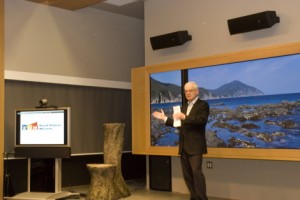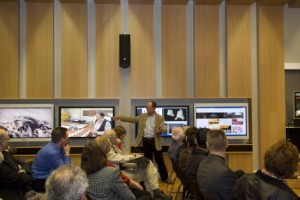The Royal Ontario Museum’s Digital Path
Gail Chiasson, North American Editor

William Thorsell in Earth Rangers Studio
The current, innovative digital technology in the ROM, as the museum is generally known, enhances a visitor’s experience as well as highlights new, leading-edge initiatives that will further enrich ROM visits in coming years.
Both on-site and online digital tools present new opportunities for visitors to learn more about objects in a personalized, self-directed way, with exhibitions becoming at once more accessible, educational and entertaining.
“Rather than technology diluting the importance of real objects, on-site technology and the Web effectively accentuate the enjoyment of coming to an artifact-rich museum such as the ROM,” says William Thorsell, ROM director and CEO. “More than ever, people value the authentic experience of the extraordinary artifacts and specimens displayed at the ROM. Their experience gains in depth, before and after a visit via the Museum’s Web site, and during a visit through the galleries’ remarkable new information technology. “
While the ROM has been taking significant steps in recent years to effectively incorporate digital media to expand learning opportunities provided in the galleries, its new digital initiatives are extensive and innovative. The Age of Dinosaurs, the Schad Gallery of Biodiversity, Digital Galleries, as well as the ROM’s Iconic Objects program, demonstrate the vast potential of the digital technology. Both the new Schad Gallery of Biodiversity and the new Earth Rangers Studio, which will open to the public May 16/09, are heavily digital.
“Much of our use of digital technology to date has focused on expanding access to our collections,” says Thorsell. “In the future, our technological tool kit will be crucial to helping diverse audiences appreciate and benefit from our collections.”
ROM visitors can now encounter examples of digital technology reflecting the ROM’s vision of the modern museum experience – with e-labelling, video, broadcast, touch screens, projections and enhanced Web content enabling a richer understanding of the rare objects within.
Before visiting, ROM management recommends that the experience begins at home or school with ticket purchase and booking options as well as teaching capability. Video segments on the ROM Web site take the visitor inside the vaults or into the field. After visiting, people of all ages can extend their experience through microsites, podcasts and connection to social media applications such as YouTube, Facebook and video blogs.

Brian Porter, Asst. V-P, New Media
In other areas, small digital screens give information on objects being viewed in a showcase, for example, and allow visitors to zoom in and learn more on specific items that interest them. More detailed e-labelling throughout the museum is also planned.
The ROM plans to develop themed tours in several languages, allowing visitors to create downloading information tailored to their area and level of interest. Plans also include the addition of more video kiosks, video screens, and projections, which provide the ability to regularly update information for the visitor and make exhibitions even more engaging for all ages.
Opened in 1914, the ROM is Canada’s largest museum of natural history and world cultures, with 6 million objects in its collections and galleries showcasing art, archeology and natural science.
A fundraising initiative will be launched to support the ROM’s goal of increasing public digital access.

Follow DailyDOOH